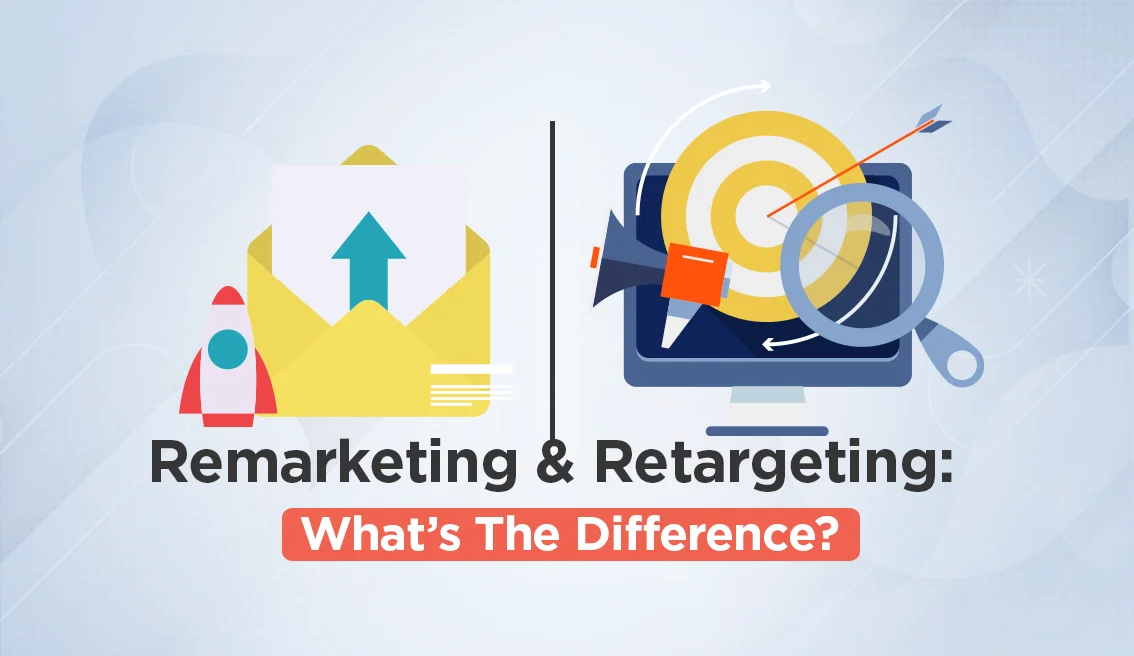A lot of people browse online stores, check out products, or even add things to their carts, then leave without buying.
That’s where Remarketing vs Retargeting strategies come into play. Both are designed to remind shoppers of their interest and give them a little nudge toward completing a purchase.
Remarketing usually focuses on past or existing customers and often happens through email.
For example, if someone abandons their cart, they might get a reminder email or even a discount to encourage them to finish the order. It not only saves lost sales but also builds trust and loyalty.
Retargeting, on the other hand, uses paid ads. If someone visits your site but doesn’t buy, they might see your product again later while browsing other sites or scrolling social media.
This keeps your brand top of mind and increases the chances they’ll come back.
While the two terms often get mixed up, they serve different purposes.
Used together, remarketing and retargeting are a powerful combo for reducing cart abandonment, boosting conversions, and keeping customers engaged throughout their journey.
What is Retargeting?
Retargeting is highly cost-effective and is considered one of the answers to what are five marketing strategies that retailers spend half of their annual budget on, because it focuses on warm audiences. Using enterprise search engine optimization services, businesses can enhance their retargeting efforts by ensuring that their content is easily discoverable, thus attracting more potential customers who are already familiar with their brand.

It works by using cookies or tracking pixels to monitor user behavior and then displaying personalized ads, essentially answering what is the digital marketing strategy that tracks users across the web?, as they browse other websites, social media platforms, or search engines.
Common channels for retargeting include Google Ads, display networks, social media, and top search engines like Google and Bing, where brands can re-engage potential customers with relevant promotions.
For example, a user may browse an online store for shoes, leave without buying, and later see ads for those exact shoes, like when you learn how to search a word on a website and pinpoint exact content, while scrolling on Facebook.
This repeated exposure keeps the brand top of mind and encourages users to return and complete their purchase.
While retargeting ads are effective, privacy-conscious users might prefer alternatives like DuckDuckGo vs Google, especially when avoiding personalized ad tracking.
Explore Our Digital Marketing Services!
What is Remarketing?
Remarketing is a strategy focused on re-engaging past customers or leads, most often through email marketing.
It works by using collected customer data from email lists or CRM systems to deliver personalized messages that encourage users to return and take action. By integrating b2b content marketing services, businesses can target specific customer segments with highly relevant content that drives conversions and increases customer retention.

Common remarketing efforts include email campaigns, tailored product recommendations, special discounts, and loyalty offers that strengthen customer relationships and build trust.
For instance, if a customer abandons their shopping cart, a remarketing email can be sent reminding them to complete the purchase, sometimes with an added incentive like free shipping or a discount.
This approach not only helps recover lost sales but, when combined with digital transformation services, enhances brand loyalty by keeping customers connected with the business.
7 Key Differences: Remarketing vs Retargeting
Remarketing and retargeting are two essential digital marketing strategies used to reach different audiences and achieve specific objectives. While they have similar goals, they utilize different methods and tools to re-engage users.
Below is a detailed comparison of the two, highlighting key differences and similarities.
| Aspect | Retargeting | Remarketing |
|---|---|---|
| Channel of Use | Primarily uses online display ads across platforms like Google Ads, Facebook, Instagram, YouTube, and third-party websites.- Banner ads, video ads, and dynamic product ads. | Focuses on email campaigns such as cart reminders, promotional offers, loyalty rewards, and newsletters.- Primarily email-driven. |
| Audience Type | Targets new visitors who didn’t convert.- Example: Users who visited a product page but didn’t make a purchase. | Targets existing customers or leads who have shared their contact information.- Example: Past buyers or people who signed up for a newsletter. |
| Technology Used | Relies on cookies and tracking pixels to track user behavior across multiple websites.- Uses tools like Google Ads Pixel, Facebook Pixel. | Utilizes email lists, CRM systems, and user data (e.g., past purchases, abandoned carts).- Tools like Mailchimp, HubSpot, Salesforce. |
| Best Suited For | Ideal for awareness and consideration stages of the customer journey.- Focuses on re-engaging people who are still in the evaluation phase. | Best for conversion, retention, and loyalty.- Aimed at keeping existing customers engaged or encouraging repeat purchases. |
| Cost and Budgeting | Costs can vary based on the platforms (Google Ads, social media), and the frequency of ads shown.- Can be more expensive due to reliance on paid ads. | Generally more cost-effective for businesses with established customer lists.- Relies on email infrastructure, which is often more affordable. |
| Content Type | Content is ad-based (dynamic ads, display banners, videos, and promotional graphics).- Relies on attention-grabbing creatives. | Content is usually email-based (personalized product recommendations, offers, loyalty messages).- Often more informative or transactional in nature. |
| Frequency of Exposure | Can be more frequent with display ads appearing across multiple sites and social media.- Users may see multiple ads over time. | Typically less frequent, often triggered by specific actions like abandoned carts or milestone dates (e.g., loyalty rewards). |
5 Similarities Between Remarketing and Retargeting
Although remarketing and retargeting use different methods, they share several important similarities that make them effective digital marketing strategies.
| Similarity | Explanation |
|---|---|
| Re-engaging Users | Both strategies aim to reconnect with users who previously interacted with the brand but didn’t complete a desired action. |
| Boosting Conversions & ROI | By focusing on warm leads (users who are already familiar with the brand), both strategies are highly effective in improving conversion rates and maximizing ROI. |
| Data-Driven & Personalized | Both strategies rely on data insights to target specific user segments, using browsing history, purchase data, and email interactions to create personalized experiences. |
| Increasing Customer Loyalty | Both can contribute to long-term customer loyalty by keeping users engaged and offering personalized incentives, discounts, and follow-up communications. |
| Efficient Use of Resources | Both are cost-effective methods compared to broader audience targeting, focusing on users who have already expressed interest. |
When to Use Retargeting?
Now that the differences between retargeting and remarketing are clear, it’s important to understand when retargeting is the right choice for your marketing strategy.
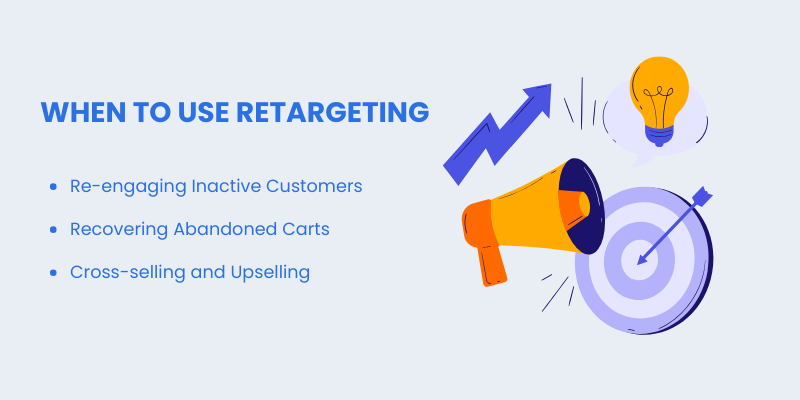
1. Working with a Limited Ad Budget
Retargeting is highly cost-effective because it focuses on users who already know your brand. Instead of spending broadly, you direct your budget toward a warm audience, making every click more efficient.
2. Building Brand Awareness
If your goal is to keep your brand top of mind, retargeting is a great tool. By consistently showing ads to users who’ve previously engaged with your website or content, you strengthen recognition and ensure they don’t forget your brand.
3. Boosting Ad Engagement
Retargeting delivers personalized ads based on a user’s previous interactions, which makes the ads more relevant and engaging. This increases the likelihood of clicks, interactions, and ultimately helps increase conversion rate by reaching already-interested users.
Explore Our Performance Marketing Services!
When to Use Remarketing?
Remarketing is best applied when you want to reconnect with your existing customers or subscribers through email campaigns.
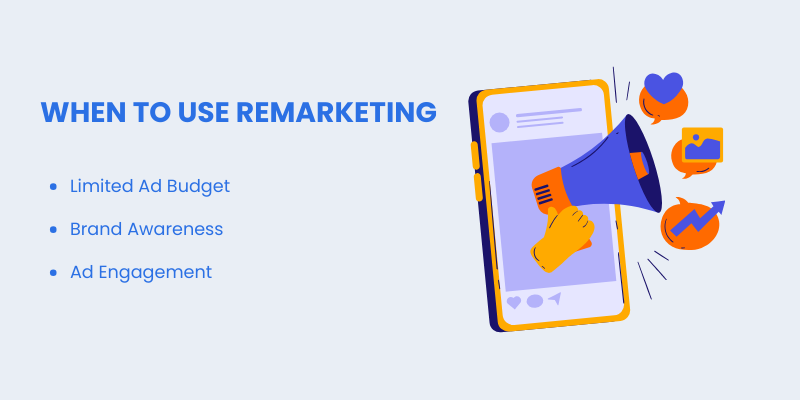
1. Re-engaging Inactive Customer
Email remarketing is perfect for reaching customers who haven’t interacted with your brand in a while.
Tailored emails, especially for B2B Web Design Development and other niche sectors, can entice users back with fresh content or offer content branding solutions.
2. Recovering Abandoned Carts
For businesses struggling with cart abandonment, remarketing emails are a proven solution. Sending reminders or offering discounts can encourage users to complete their purchase.
3. Cross-Selling and Upselling Opportunities
Remarketing also enables personalized product suggestions. By analyzing past purchases, much like reviewing advertisement examples, you can recommend complementary products or upgrades, increasing sales and enhancing customer value.
Benefits and Drawbacks of Retargeting and Remarketing
Retargeting and remarketing are two powerful digital marketing strategies that can help businesses re-engage their audience, boost conversions, and increase sales. However, each approach comes with its own set of advantages and challenges. Below, we will explore the benefits and drawbacks of both retargeting vs remarketing to help you determine which strategy is best suited for your marketing goals.
Retargeting
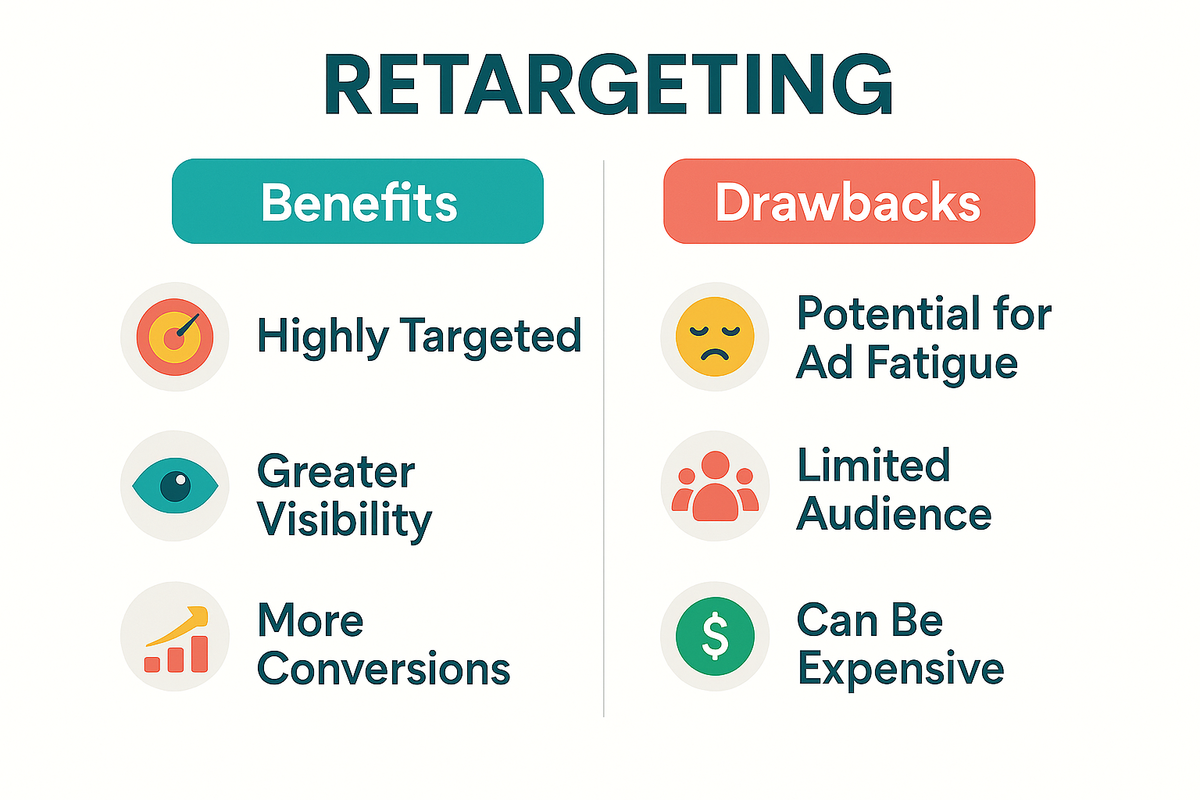
✅ Benefits
1. Highly Targeted
One of the main advantages of retargeting and remarketing is their ability to engage individuals who have already shown interest in your brand. By targeting people who have interacted with your website, product pages, or ads, you can refine your ad delivery, making your marketing efforts more effective and cost-efficient. This precise targeting ensures that you’re reaching out to people who are already familiar with your brand, increasing the likelihood of conversions.
2. Greater Visibility
Retargeting vs remarketing also offers better visibility. By serving ads to users who have previously engaged with your brand, you keep your products or services top-of-mind. This repeated exposure can help maintain a connection with users, making them more likely to revisit your site and complete their purchases or desired actions.
3. More Conversions
Since retargeting focuses on people who have already engaged with your brand, these individuals are often closer to making a purchase decision. By continuing to expose them to targeted ads, retargeting helps convert these warm leads into paying customers, ultimately driving revenue.
❌ Drawbacks
1. Potential for Ad Fatigue
A significant challenge of retargeting vs remarketing is the risk of ad fatigue. When users see the same ad repeatedly, it can lead to annoyance and negative perceptions of the brand. Overexposure to ads can cause users to become frustrated, which may reduce the effectiveness of your campaigns and harm brand perception.
2. Limited Audience:
Retargeting and remarketing are both restricted to individuals who have already interacted with your brand. This limitation can prevent you from reaching new customers who may not yet be familiar with your business, making it difficult to expand your audience.
3. Can Be Expensive:
Depending on the platform and the scale of your campaign, retargeting can be costly, especially if you are targeting a large audience or using high-traffic ad networks. This can be a significant consideration for businesses with limited budgets or smaller audiences.
Remarketing
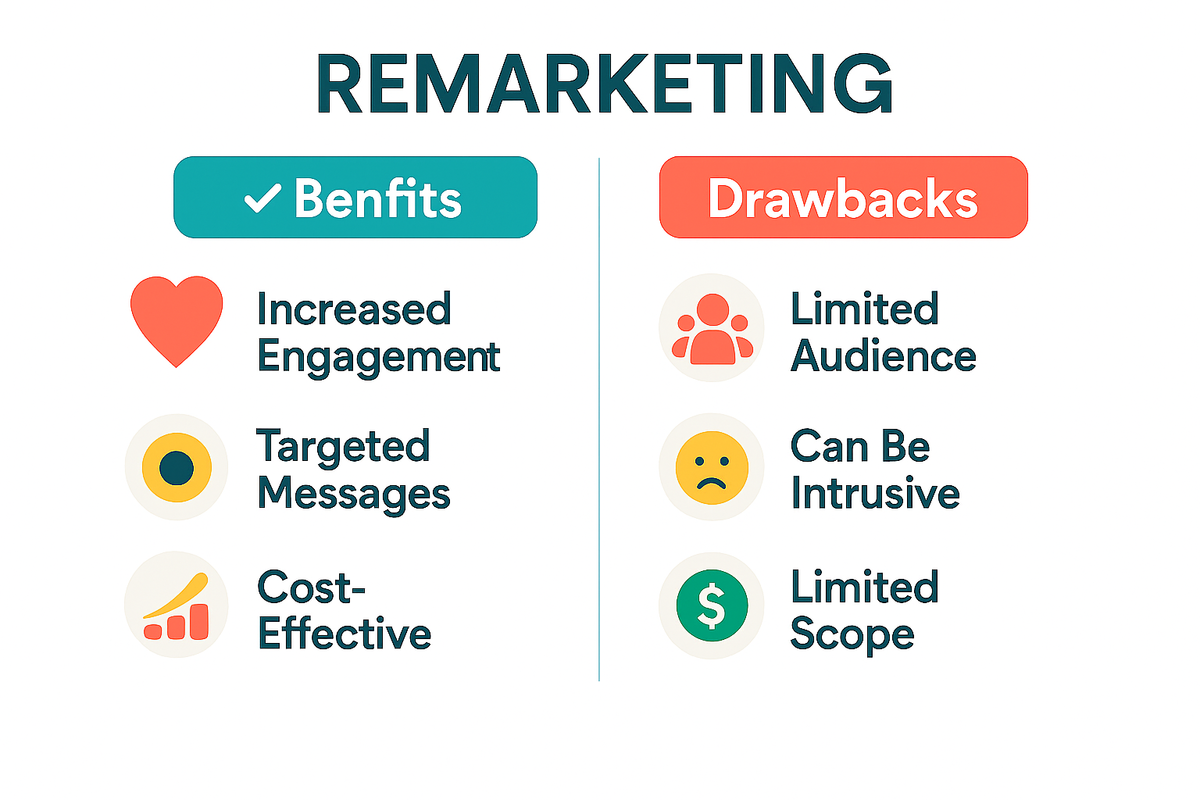
✅ Benefits
1. Increased Engagement
Remarketing and retargeting both involve reaching out to people who have shown interest in your brand, but remarketing often takes a more personalized approach. Through email or direct messages, remarketing allows you to deliver targeted and tailored content to users, increasing engagement and driving more conversions.
2. Targeted Messages
One of the key advantages of remarketing vs retargeting is the ability to send highly personalized messages. By leveraging customer data, you can create messages that speak directly to users’ previous actions, such as offering discounts or recommending complementary products. This customization makes your marketing efforts more relevant and appealing, increasing the chances of conversion.
3. Cost-Effective
Remarketing campaigns are often more budget-friendly, especially when relying on email as the primary communication channel. Since email is a relatively low-cost tool, remarketing can be an effective strategy for smaller businesses or those targeting a more niche audience.
❌ Drawbacks
1. Limited Audience
Like retargeting, remarketing is also confined to users who have already engaged with your brand. If your goal is to expand your customer base or reach new audiences, remarketing may not be the best approach, as it focuses on people already within your customer ecosystem.
2. Can Be Intrusive
While remarketing is a great way to re-engage customers, it can sometimes feel invasive. If users feel like they are being bombarded with constant emails or personalized messages, it could negatively impact your brand's reputation and lead to customer frustration.
3. Limited Scope
A notable drawback of remarketing is that it typically relies on your email list, restricting the scope of your campaigns. Since you can only reach out to individuals who have opted into your communications, this limits your ability to reach potential new customers, particularly those who haven’t provided their contact details.
Tools and Platforms for Effective Retargeting and Remarketing
Discover the best tools and platforms to optimize your retargeting and remarketing campaigns for better engagement and conversions
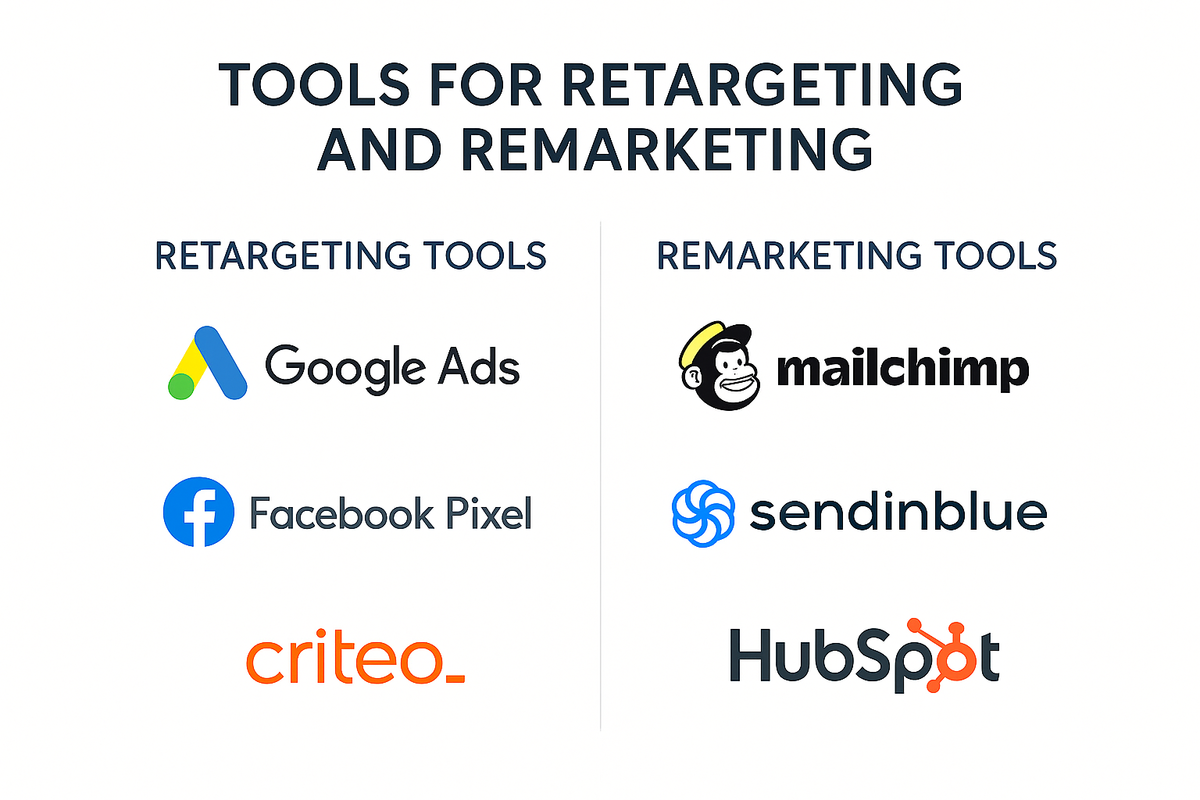
Retargeting Tools:
- Google Ads: Utilizes Google’s vast display network to reach users across websites, videos, and apps, offering broad reach for your retargeting campaigns.
- Facebook Pixel: Tracks user behavior on your site and enables you to serve ads on Facebook and Instagram, providing a highly effective retargeting mechanism.
- Criteo: Specializes in dynamic product ads, offering a personalized retargeting experience that works well for e-commerce sites.
Remarketing Tools:
- Mailchimp: A leading email marketing platform that allows you to craft and automate personalized emails, ideal for remarketing campaigns.
- SendinBlue: Offers email marketing automation with segmentation features, perfect for remarketing efforts.
- HubSpot: Combines CRM with email marketing, enabling businesses to send remarketing emails and track customer behavior across different touchpoints.
How to Measure Success? 6 KPIs to Consider
Both retargeting and remarketing rely on various KPIs to assess their effectiveness. Understanding which metrics to track will help you refine your strategy over time.
- Click-Through Rate (CTR): Measures how effective your retargeting vs remarketing ads are at prompting users to engage. A higher CTR typically indicates effective targeting.
- Conversion Rate: Whether you’re using retargeting ads or remarketing emails, tracking conversion rates will show how many users took the desired action after interacting with your content.
- Return on Ad Spend (ROAS): A critical metric for understanding the profitability of your retargeting campaigns. For remarketing, focusing on CLTV (Customer Lifetime Value) might give you a deeper insight into the long-term value of re-engaged customers.
- Customer Lifetime Value (CLTV): Remarketing campaigns are often designed to maximize CLTV, ensuring that customers continue purchasing over time. Tracking CLTV will help you understand how effectively your remarketing/retargeting efforts are fostering long-term relationships.
- Cost Per Conversion: Understanding how much you are spending to convert a user is essential for both retargeting vs remarketing. This metric helps you assess the cost-effectiveness of your campaigns.
- Bounce Rate of Retargeted Visitors: A high bounce rate among retargeted visitors might indicate that your ads are not targeting the right audience or are too repetitive, which can harm your retargeting and remarketing efforts.
Benefits of Combining Both Remarketing Retargeting
Using remarketing and retargeting together creates a more powerful and complete customer engagement strategy.
While each method has its own strengths, combining them ensures that businesses can reach users at different stages of the sales funnel and maximize results.
One of the key advantages is building a holistic customer re-engagement strategy. Retargeting helps bring back new visitors who showed interest but left without converting, while remarketing nurtures existing customers with personalized emails and offers.
Together, they create a seamless journey that guides users from awareness to conversion and beyond.
This combination also ensures wider sales funnel coverage, as businesses are not only targeting potential customers but also strengthening relationships with existing ones.
By addressing both groups through integrated digital marketing services, companies reduce missed opportunities and increase overall conversion rates.
Finally, using both strategies reinforces brand recall and loyalty.
Frequent exposure through ads, paired with personalized follow-ups via email and insights from best SEO reporting software, keeps the brand top-of-mind, builds trust, and encourages repeat purchases.
FAQs: Remarketing vs Retargeting
What is the difference between remarketing and retargeting?
Remarketing typically uses email campaigns to re-engage past customers, while retargeting uses online ads to bring back new visitors who didn’t convert.
Is retargeting or remarketing more cost-effective
Both are cost-efficient, but retargeting often delivers faster results with a limited budget since it targets warm audiences who already showed interest.
Can I use remarketing and retargeting together?
Yes. Combining both creates a stronger strategy retargeting brings back new visitors, while remarketing nurtures existing customers for loyalty and repeat sales.
Which is better for reducing cart abandonment?
Remarketing is more effective, as personalized emails with reminders or incentives can directly encourage customers to complete their purchase
Does retargeting improve brand awareness?
Absolutely. Just like Google keyword ranking keeps your SEO efforts visible, retargeting repeatedly shows ads to interested users across websites and platforms, strengthening brand recall and recognition.
What is an example of remarketing?
An example of remarketing is showing ads for a product a customer viewed but didn’t purchase, reminding them to complete the purchase.
What is the main difference between website retargeting and dynamic remarketing?
Website retargeting shows the same ads to users who visited your site, while dynamic remarketing displays personalized ads based on the specific products or services they viewed.
What is the difference between targeting and retargeting?
Targeting reaches new users, while retargeting focuses on re-engaging users who have already interacted with your brand but didn’t convert.
Conclusion
Remarketing vs Retargeting are both powerful strategies designed to re-engage potential customers, but they work in different ways. Retargeting relies on online ads to reconnect with new visitors who showed interest but didn’t convert, making it most effective during the awareness and consideration stages of the sales funnel. Remarketing, on the other hand, focuses on existing customers or leads through personalized email campaigns, making it ideal for nurturing relationships, reducing cart abandonment, and encouraging repeat purchases.
While they are often used interchangeably, the distinction lies in their channels, audiences, and goals. Retargeting is best for driving users back to the website, while remarketing excels at deepening loyalty and maximizing customer lifetime value. The most effective strategies blend remarketing, retargeting, and performance marketing to create a well-rounded, ROI-focused approach. By using retargeting to capture new prospects and remarketing to strengthen relationships with existing customers, businesses, like Centric, can create a holistic, conversion-driven approach that maximizes ROI and long-term growth.
